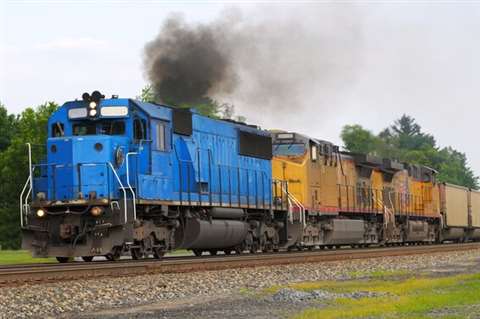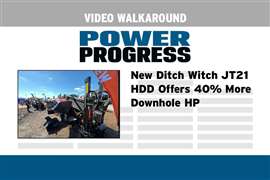California stiffens locomotive emissions standards
27 April 2023
Operator-funded pool can be used to update emissions technologies
The California Air Resources Board (CARB) passed a new rule aimed at reducing emissions from locomotives when they operate within the state.
Under the In-Use Locomotive Regulation, operators will now be required to pay into a spending account, and the amount will be determined by the emissions they create while operating in California. Companies will be able to use the funds to upgrade to cleaner locomotive technologies. Locomotives also will have a 30-minute idling limit. Additionally, switch, industrial and passenger locomotives built in 2030 or after will be required to operate in zero-emissions configurations while in California, and in 2035 for freight line haul.
 The California Air Resources Board (CARB) today passed a new rule aimed at reducing emissions from locomotives when they operate within the state. Under the In-Use Locomotive Regulation, operators will now be required to pay into a spending account, and the amount will be determined by the emissions they create while operating in California. Companies will be able to use the funds to upgrade to cleaner locomotive technologies. (Image: CARB)
The California Air Resources Board (CARB) today passed a new rule aimed at reducing emissions from locomotives when they operate within the state. Under the In-Use Locomotive Regulation, operators will now be required to pay into a spending account, and the amount will be determined by the emissions they create while operating in California. Companies will be able to use the funds to upgrade to cleaner locomotive technologies. (Image: CARB)
“Locomotives are a key part of California’s transportation network, and it’s time that they are part of the solution to tackle pollution and clean our air,” said CARB Chair Liane Randolph. “With the new regulation, we are moving toward a future where all transportation operations in the state will be zero emissions.”
CARB said emissions reductions from the new regulation are expected to be equal to almost double those emitted by all passenger vehicles in the state between now and 2050. It is projected that the In-Use Locomotive Regulation will contribute the largest reduction in nitrogen oxide emissions toward meeting California air quality standards by the 2037 deadline.
The reduced nitrogen oxide and diesel particulate matter are estimated to bring an estimated $32 billion in health savings by preventing 3200 premature deaths and 1500 emergency room visits and hospitalizations, the agency said. It also estimates that cancer risk from exposure to air toxins within one mile of locomotive operations is expected to be reduced by 90%.
The new rules offer flexibility to come into compliance, including alternatives to meet milestone deadlines and extensions for reasons that can include issues with available technologies or emergency situations, CARB said. Funding programs are available, particularly for companies that are taking early action or those looking to go beyond the regulation’s requirements. Funding support may be available through the Carl Moyer Program, Community Air Protection Incentives, Volkswagen Environmental Mitigation Trust, and other programs such as Advanced Technology Demonstration and Pilot Projects funded through the Low Carbon Transportation program. Additionally, billions in federal grants and rebates to reduce air pollution are available for operators.
Starting in 2024: Spending Account
Locomotive operators would be required to fund their own trust account based on the emissions created by their locomotive operations in California. The dirtier the locomotive, the more funds must be set aside.
Spending Account funds would be used in the following manner:Until 2030, to purchase, lease, or rent Tier 4 or cleaner locomotives, or for the remanufacture or repower to Tier 4 or cleaner locomotive(s).At any time, to purchase, lease, or rent ZE locomotive(s), ZE capable locomotive(s), ZE rail equipment, or to repower to ZE locomotive(s) or ZE capable locomotive(s).At any time, for ZE infrastructure associated with ZE locomotive(s), ZE capable locomotive(s), ZE rail equipment.At any time, to pilot or demonstrate ZE locomotives or ZE rail equipment technologies.
2. Starting in 2030: In-Use Operational Requirements
Only locomotives less than 23 years old would be able to be used in California.
Switchers operated by Class I, Class III, industrial and passenger locomotive operators with an original engine build date of 2030 and beyond would be required to operate in a ZE configuration to operate in California.
Passenger locomotives with an original engine build date of 2030 and beyond would be required to operate in a ZE configuration to operate in California.
Class I line haul locomotives with an original engine build date of 2035 and beyond would be required to operate in a ZE configuration to operate in California.
3. Starting in 2024: Idling Limit
All locomotives with automatic shutoff devices would not be permitted to idle longer than 30 minutes, unless for an exempt reason. Exemptions align with those described by U.S. EPA., and would be granted for reasons like maintaining air brake pressure or keeping the driver cabin heated or air conditioned.
4. Starting in 2024: Registration and Reporting
Locomotives operating in the state would be required to register with CARB.
Reporting includes and annual administrative payment.
Locomotive activity, emission levels and idling data would be required to be reported annually.
5. Additional Options Under the Proposed Regulation
Alternative Compliance Plan: As an alternative to the Spending Account, the In-Use Operational Requirements, or both, the Proposed Regulation offers an Alternative Compliance Plan, which would allow locomotive operators to reduce emissions through other strategies, provided those strategies are not already required. Alternative Compliance Plans must achieve emission reductions equivalent to or greater than those under the Proposed Regulation.
Alternative Fleet Milestone Option: As an alternative to the Spending Account and the In-Use Operational Requirements, the Proposed Regulation would allow locomotive operators to reduce emissions by committing to four operational milestones, and to offset the use of older locomotives that would have been banned under the main regulatory pathway:Beginning January 1, 2030, 50 percent of annual fleet usage in California must be from Tier 4 or cleaner locomotives.Beginning January 1, 2035, 100 percent of annual fleet usage in California must be from Tier 4 or cleaner locomotives.Beginning January 1, 2042, 50 percent of annual fleet usage in California must be from ZE locomotives, ZE capable locomotives, or ZE rail equipment.Beginning January 1, 2047, 100 percent of annual fleet usage in California must be from ZE locomotives, ZE capable locomotives, or ZE rail equipment.
Compliance Extensions:Temporary Operating Extension: The Proposed Regulation allows operation of locomotives prohibited from operation in California under the In-Use Operational Requirements under specific circumstances, such as for removal or for maintenance.Compliance Extension for delays due to compliant equipment (including infrastructure) manufacture or installation delays, or unavailability.
Small Business Hardship Extension: The Proposed regulation offers a process for small businesses to apply for a temporary extension of their obligations under the Spending Account and/or the In-Use Operational Requirements.
Historic Railroad Low-Use Exemption: Historic locomotive operators that meet specific requirements may receive permission to be exempt from obligations under the Spending Account and/or the In-Use Operational Requirements.
POWER SOURCING GUIDE
The trusted reference and buyer’s guide for 83 years
The original “desktop search engine,” guiding nearly 10,000 users in more than 90 countries it is the primary reference for specifications and details on all the components that go into engine systems.
Visit Now
STAY CONNECTED




Receive the information you need when you need it through our world-leading magazines, newsletters and daily briefings.
CONNECT WITH THE TEAM












